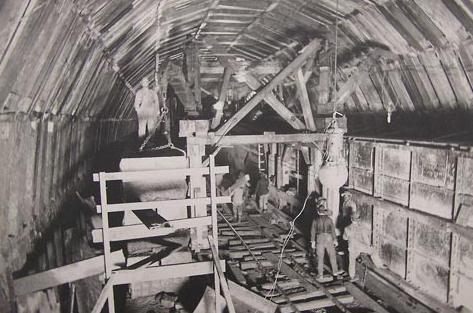![]() The Virginia Avenue is the railway tunnel currently getting all the press, but there’s actually a second, lesser-known, tunnel used by railways under Capitol Hill (and I don’t mean the little trains connected the Capitol with the congressional office buildings, either) No, it’s a tunnel that goes from Union Station south and west.
The Virginia Avenue is the railway tunnel currently getting all the press, but there’s actually a second, lesser-known, tunnel used by railways under Capitol Hill (and I don’t mean the little trains connected the Capitol with the congressional office buildings, either) No, it’s a tunnel that goes from Union Station south and west.
When the McMillan commission banded together to redo the national Mall in a manner more closely aligning to Peter L’Enfant’s original plan, the biggest obstacle they needed to deal with was the train station that was located on the northeast corner of the Mall – and the train tracks that bisected it.
Relocating the train station – as well as other stations around DC – to the expanse of land north of the Capitol was the easy part. The tracks, on the other hand, were a real problem. Unless any trains going south were sent out of DC to the east, before then making the long trek around DC before continuing into Virginia, there was no above-ground way to connect the south of the country.
Fortunately, there was a simple solution – a tunnel. And thus, on September 9, 1903, the Philadelphia, Washington, and Baltimore Railroad was given permission to build a tunnel under the Capitol. The tunnel was to be 3,000 feet long and have two tracks. The cost? A remarkably reasonable $800,000 – just under 20 million in today’s dollars.
As it turned out, the tunnel did not, in fact, go under the Capitol itself, but rather passed under 1st Street east. While the ends were done in the simpler cut-and-cover method, from B Street Southeast (Independence Avenue) to B Street Northeast (Constitution Avenue) the tunnel was built entirely underground. The work proceeded slowly but steadily, with about 5 feet being tunneled every day. This pace was maintained, despite three shifts being employed, so that work would proceed as quickly as possible. Originally, the plan had been to tunnel all the way to C Street northeast, but this was discarded in order to have the work completed more rapidly.
After two years of work, the tunnel opened in 1906, and immediately improved the flow of passenger traffic through the District. Today, it remains an important connector for points south. The only fly in Amtrak’s ointment is that it is not large enough to take auto trains, necessitating a departure from Lorton, Virginia instead.
If you want to see the tunnel, go to the corner of New Jersey Avenue and D Street southeast. There is a flight of stairs heading down from New Jersey Avenue, and you’ll see the fence surrounding the tracks on your right. Look back, and you’ll see the rough stone arches that frame the entrance to the tunnel. And if you’re lucky, you’ll see a train go through this 100+ year old engineering marvel.



Robert — thanks for the story. One other tidbit: when they were
building the Congressional Visitors Center (CVC), they built a foot
tunnel from the CVC to connect to the Jefferson Building of the Library
of Congress. But, I am told, they didn’t know exactly where the train tunnel was because the blueprint drawings were not accurate. The story is that they had to relocated the library tunnel after they ran into the train tunnel. Not sure this is true, but it might be worth looking into.
Ken
I recently noticed the tunnel in a stereoview I have. Does anyone know anything about it?